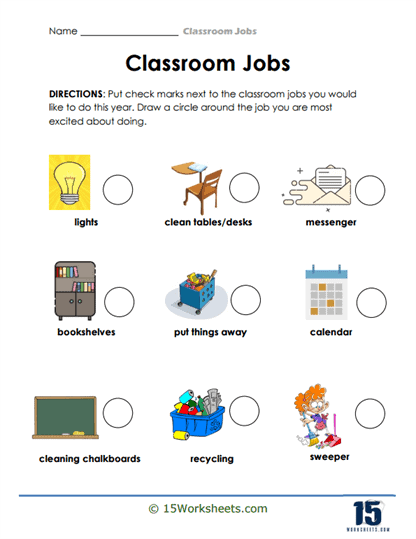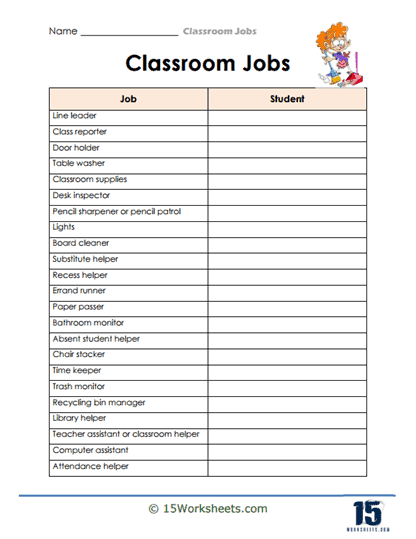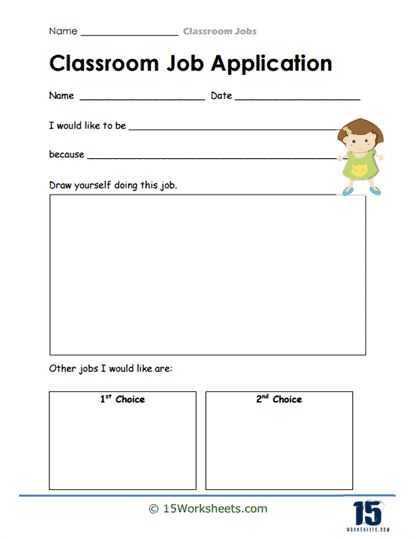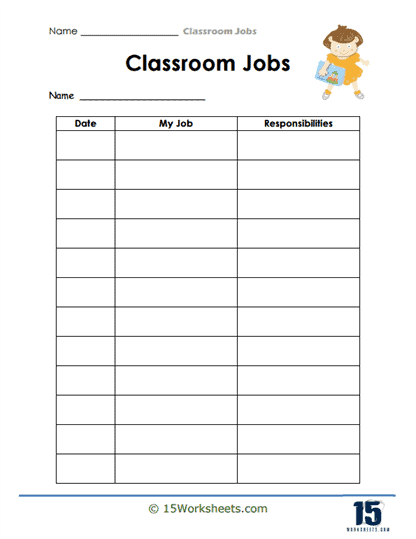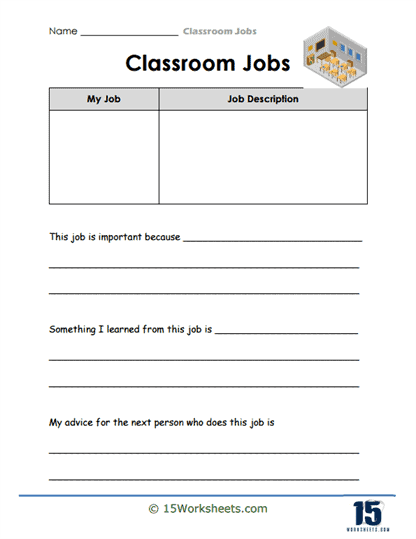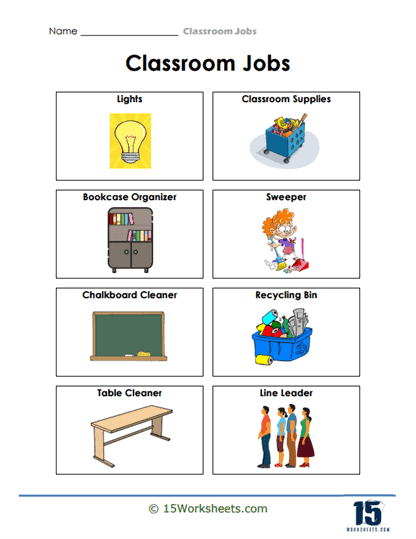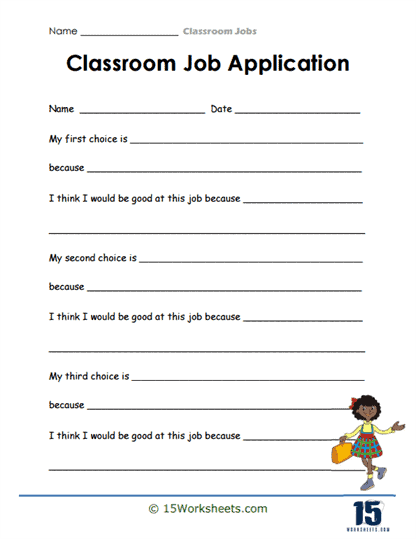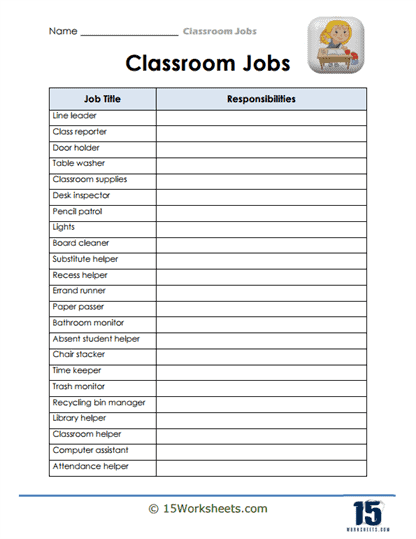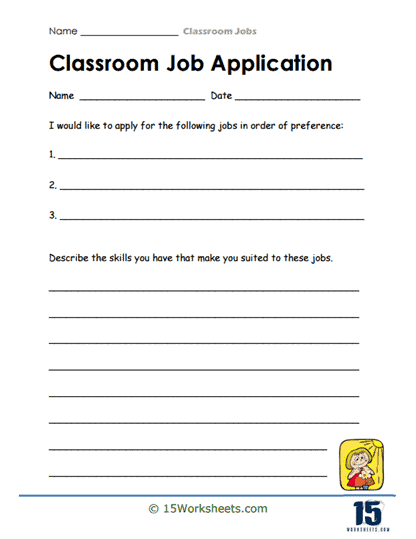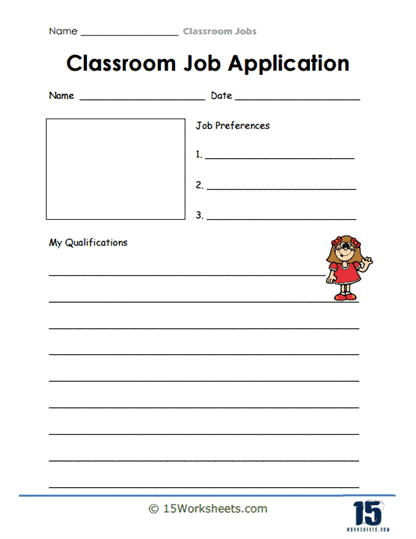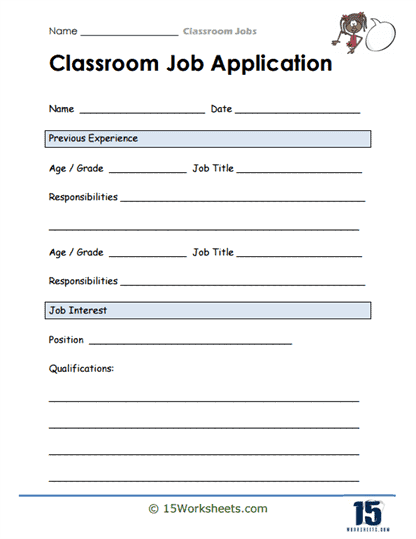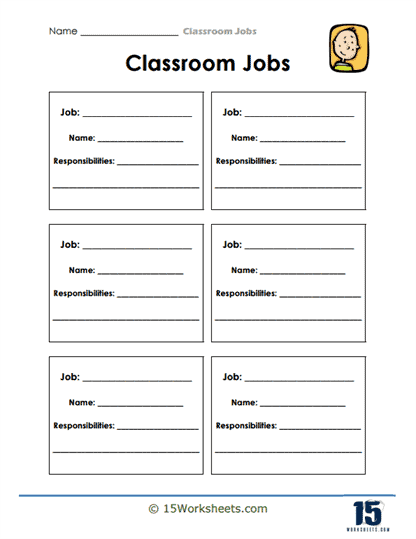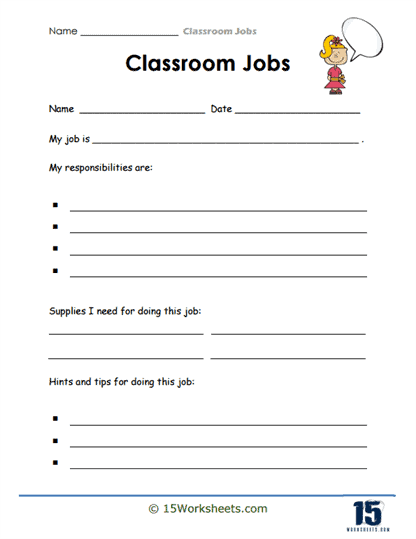Classroom Jobs Worksheets
All About These 15 Worksheets
Classroom jobs worksheets are used in classrooms, homeschools, and tutoring environments to help students take on responsibilities within the learning space. These worksheets are designed to assign and rotate various tasks or roles to students, fostering a sense of responsibility, teamwork, and organization. Both teachers and homeschool educators use these worksheets as a structured way to distribute classroom tasks, ensuring that all students contribute to maintaining the classroom environment.
The exercises featured on classroom jobs worksheets can vary widely but generally include several core components. Based on the set of images provided, here’s a detailed overview of what these types of worksheets often include:
Job Selection
Many of these worksheets focus on helping students identify the jobs they would like to take on. For example, students may be asked to place check marks next to jobs they are interested in, as seen in the first image. These jobs might range from “lights monitor” to “recycling helper” or “sweeper.” The act of selecting a role encourages students to take initiative and consider what responsibilities they would most enjoy or excel at.
Other worksheets focus on helping students rank their job preferences. For instance, one of the worksheets shows a structure where students can write down their first, second, and third job choices, explaining why they would be good at these tasks. This encourages self-reflection and gives teachers insight into each student’s interests and skills, helping to assign jobs more fairly and effectively.
Job Application Process
Several of the worksheets also introduce a more formal application process for classroom jobs, which is an excellent way to introduce students to the concept of applying for a position. Some worksheets ask students to fill out an application form, explaining why they believe they would be a good fit for the job and listing relevant skills. This teaches students about real-world processes in a simplified, classroom-friendly way, preparing them for future job applications and interviews.
Another interesting component of some worksheets is asking students to draw themselves doing the job they would like to have. This creative task encourages younger students to visualize themselves in these roles, making the concept more concrete and engaging for visual learners. This type of activity fosters creativity while reinforcing the importance of taking on responsibilities.
Job Assignment and Monitoring
In the classroom, it’s important to monitor and rotate jobs, ensuring fairness and giving every student a chance to participate in different roles. Some of the worksheets provide tables or charts where teachers can assign students to different tasks, as shown in the images. These worksheets typically have spaces for listing student names next to jobs and often include a rotating schedule, so tasks are regularly reassigned.
Detailed Job Descriptions and Responsibilities
Several worksheets provide structured spaces for students to write out the responsibilities of each job. This helps clarify what is expected of each role, which can be very helpful for younger students or those unfamiliar with the tasks. This formality also provides students with a sense of ownership and understanding of the importance of each classroom role.
A number of worksheets feature writing prompts that encourage students to reflect on the jobs they are interested in. For example, one worksheet asks students to write about one of the classroom jobs, describing the responsibilities and drawing a picture to go along with their writing. This reflective activity helps students think about why these roles are essential and how they contribute to the overall functioning of the classroom.
The collection of worksheets offers great flexibility for educators, whether they are managing a large classroom or a small homeschooling setup. Teachers can tailor the worksheets based on their specific classroom needs, the number of students, and the types of jobs that need to be filled. Some worksheets offer multiple roles, while others are simpler and focus on a few key tasks, allowing educators to choose the format that works best for their situation.
Common Classroom Jobs
Line Leader – The Line Leader is responsible for leading the class during transitions, such as moving from the classroom to the library or cafeteria. This role helps the student practice leadership skills, including staying focused and ensuring that the class moves in an orderly fashion. The Line Leader also helps the teacher by setting a good example for the rest of the students. It’s a job that rotates often so many students have the chance to be in charge.
Caboose – The Caboose is the student who makes sure no one is left behind during transitions, following at the back of the line. This role helps ensure that all students stay together and that no one gets lost or distracted. The Caboose can also help the teacher by ensuring doors are closed behind the class. This position fosters responsibility and helps students develop a sense of inclusion.
Door Holder – The Door Holder’s job is to open and close doors when the class moves between rooms. This responsibility encourages courtesy and attentiveness, as they must be aware of the class’s movement. The Door Holder helps ensure that transitions happen smoothly and that doors don’t remain unattended. It’s a small but important job that teaches helpfulness.
Messenger – The Messenger is responsible for delivering notes, messages, or materials to the office or other teachers. This role teaches trustworthiness and communication skills, as the student must remember the message and deliver it accurately. The Messenger often gets to leave the classroom briefly, which can be a fun break from routine. It also allows students to practice independence in a responsible way.
Pencil Monitor – The Pencil Monitor sharpens pencils for the class and makes sure the pencil supply is replenished. They ensure that all students have the tools they need to complete their work, reducing disruptions during lessons. This job fosters organizational skills and attention to detail. It also gives the student a sense of responsibility for the class’s overall productivity.
Paper Passer – The Paper Passer distributes worksheets, handouts, or other papers to classmates. This role helps the class run more smoothly by cutting down on transition time and freeing the teacher to focus on instruction. The Paper Passer also practices efficiency and awareness by quickly and neatly passing out materials. This job promotes teamwork and helps build organizational skills.
Librarian – The Librarian ensures that the classroom library remains tidy and organized, returning books to their correct places and making sure they are well cared for. This role teaches respect for shared resources and responsibility for keeping the classroom in order. The Librarian may also assist classmates in finding books and suggest interesting reads. This job is perfect for students who love reading and organization.
Chair Stacker – The Chair Stacker is in charge of making sure chairs are stacked neatly at the end of the day. This job helps keep the classroom organized and ready for the next day. It teaches students to take responsibility for shared spaces and to work quickly and efficiently. This role also reinforces the importance of cleanliness and preparation.
Tech Assistant – The Tech Assistant helps the teacher with basic technology tasks, such as turning on the projector, managing classroom devices, or ensuring that iPads or laptops are charged and ready. This role encourages technical skill development and responsibility for valuable equipment. It also helps the class move more smoothly when technology is needed. The student must be reliable and ready to help solve simple tech issues.
Board Eraser – The Board Eraser wipes the whiteboard or chalkboard at the end of lessons or the school day. This task helps ensure the board is clean for the next use and reinforces the importance of maintaining a neat learning space. It’s a simple task that requires attention to detail and readiness to act when the teacher needs assistance. The Board Eraser helps the class transition smoothly between subjects.
Timekeeper – The Timekeeper is responsible for keeping track of time during activities or lessons, alerting the teacher when it’s time to transition or end an activity. This role fosters punctuality and awareness of time management. The Timekeeper can help keep lessons on track, ensuring smooth transitions throughout the day. It’s a job that promotes attention to detail and self-management.
Classroom Cleaner – The Classroom Cleaner helps keep the classroom tidy by picking up trash, straightening desks, or organizing supplies. This role teaches students the importance of maintaining a clean environment and being responsible for their surroundings. It helps foster pride in the classroom and encourages students to work together to keep things orderly. This role can rotate, ensuring that all students take part in maintaining a clean space.
Line Monitor – The Line Monitor ensures that the line remains quiet and orderly during transitions. This job encourages leadership and responsibility, as the Line Monitor must help classmates stay focused and follow directions. The student in this role helps the teacher manage behavior during busy transitions. It also fosters self-control and awareness of others.
Snack Helper – The Snack Helper assists with passing out or setting up snacks during snack time, helping ensure everyone gets their share. This job teaches responsibility and the importance of taking care of others. It encourages students to practice organization, hygiene, and helpfulness. Snack time becomes smoother and more efficient with the help of the Snack Helper.
Attendance Monitor – The Attendance Monitor helps the teacher by taking attendance, noting who is absent, and ensuring that records are accurate. This role teaches responsibility and attention to detail, as the student must be observant and careful in tracking classmates. It also helps the teacher manage one of the classroom’s daily routines. The student in this role often develops organizational skills and gains a sense of importance.
Calendar Helper – The Calendar Helper is responsible for updating the classroom calendar, adding the day, date, or special events. This job teaches students how to read and use a calendar, enhancing their awareness of time and planning. The Calendar Helper gets to announce upcoming events or changes to the class. It’s an engaging job that promotes time management and organizational skills.
Weather Reporter – The Weather Reporter checks the day’s weather and reports it to the class during morning routines. This job encourages curiosity about the natural world and helps the student develop communication skills by sharing information with classmates. The Weather Reporter might also learn to use weather apps or thermometers. It’s a fun way to incorporate science and observational skills into daily routines.
Desk Inspector – The Desk Inspector checks to ensure that desks are tidy at the end of the day, reminding classmates to clean up. This role promotes responsibility for personal space and helps the class maintain a neat learning environment. It teaches accountability and helps classmates stay organized. The Desk Inspector’s work supports a clean, distraction-free classroom.
Recycling Monitor – The Recycling Monitor ensures that recyclable materials are properly sorted and placed in the correct bins. This role promotes environmental awareness and responsibility by encouraging students to think about waste management. The student in this role may also teach classmates about recycling practices. It’s an important job for fostering sustainability and responsibility.
Substitute – The Substitute steps in to cover any classroom job when a classmate is absent or unavailable. This flexible role teaches adaptability and problem-solving, as the Substitute must be ready to fill in wherever needed. It also encourages the student to be observant and responsible for multiple tasks. The Substitute’s role supports the smooth functioning of the classroom by ensuring no job is left undone.


